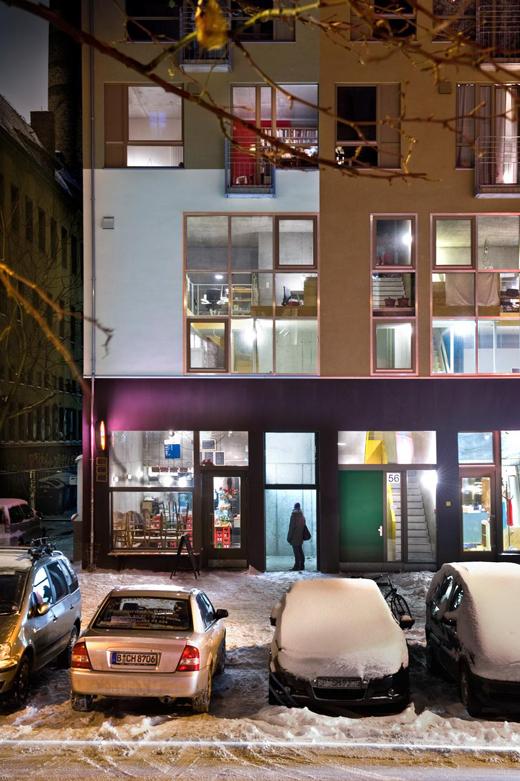Have you met... die raum
Have you met... die raum

There is a certain exhibition space in the middle of a jungle ruled by proud stroller-pushing parents and compulsive coffee drinkers that really worth a visit to the heart of Prenzlauer Berg.
die raum is a 5 m2 exhibition space in the multifunctional house in Oderberger Straße 56 designed by BARarchitekten.
Run by Jesper Dyrehauge and Lotte Møller, they are just celebrating their first anniversary after eight exhibitions and a reasonable amount of fun.
They claim to be the smallest art space with the biggest flyer: for each exhibition they produce a poster in collaboration with the exhibiting artist that is also part of their concept.
But the danish curator combo has very different backgrounds and fields of work. Lotte studied Art History before landing in Berlin. Her work comprises writing and dealing with artists in terms of production, while Jesper is an artist himself. He has worked in public space before, but now primarely works with a variation on painting using different printing techniques.
I met them in Oderberger Straße and we talked about artist salaries, modernism and, as the song goes, how they get by with a little help from their friends.
What is the main concept behind your space?
BAR architects originally conceived this building as a house for functional spaces, including their own studio, workshops and apartments, a shop, a café, and of course die raum. They purposely designed it to become a room for art. We just made an agreement with them: to fill the space and keep it alive
How does it work with such spatial conditions?
The room might have its limitations, but we haven't met them yet. It's been used in many ways that we never thought. It's amazing how ideas transform themselves in just 5m². In that sense, it's really comfortable to work like this, it's way easier to maneuver here than in a bigger room
What about the surrounding circunstances?
The house is embracing die raum, it perfectly fits into the social structure of the house. It's also interesting the fact that the space doesn't have a history. It's not a former butchery, there are no traces of anything from the past.
The people from the house is also highly involved. The room is home alone during opening times but they help us with the maintenance of the shows

Rose Eken, There is a light that never goes out
How do you finance this project?
Since this is a collaborative project we don't have to worry about rent expenses. Production costs are often split with the artists and sometimes they can apply for funds to their countries embassies and departments of culture.
We like doing this, so this project is mainly based on our free energy, we are not willing to make it generate any incomes. It's also great that we can count with the help of friends like Alexander Schmidt, our graphic designer, or the photographer Jan Windszus. Our artist friend Paul McDevitt let us use his Risograph (a japanese printing machine which is something between a copy machine and off set printer) to print our posters
What are your curatorial interests?
We have different interests but we always agree instantly. The way we work responds to sudden impulses. We don't have a program as such, we avoid to have a system. Sometimes our shows consist on a performance, but there was also a lot of music-related projects. What we consider really important is to find someone who can work with the space in a new and interesting way. The room restriction is setting all the boundaries here, however the artists that we invite like the fact that the space is confined
What did you learned over the time? Any remarkable experiences?
When the artist duo Vinyl-Terror & -Horror came up like “Hey guys, we're a gonna push a caravan into the space”... that was quite an experience. We had a long discussion with the Ordnungsamt because the custom-made sculpture popped out of the space into the street. They claimed lots of potential dangers and catastrophes that taking four meters of pavement might cause. That was ridicuolous. But since these artists often work in public spaces they are already used to deal with the kind of situations in which they have to find new solutions. So we ended up having the caravan in a parking lot in front of the space, what turned to be a very interesting sculptural idea

Vinyl-Terror & -Horror, Adaptation 2011
What are your favourite spaces for art?
Akademie der Künste, in West Berlin. It's kind of a hidden place behind the trees. That's so beautiful, almost exotic. And the exhibitions are just great. It would be so nice to make an exhibition there...
What about the future? How do you see die raum in five years?
We don't really think that far, we are still developing this project and want to keep it that spontaneous.
In the future we would like to do some collaborative partnership. We read that note about the exchange project Berlin - Los Angeles on Bpigs and thought that it would be nice to make more contacts with other countries, to strength the network